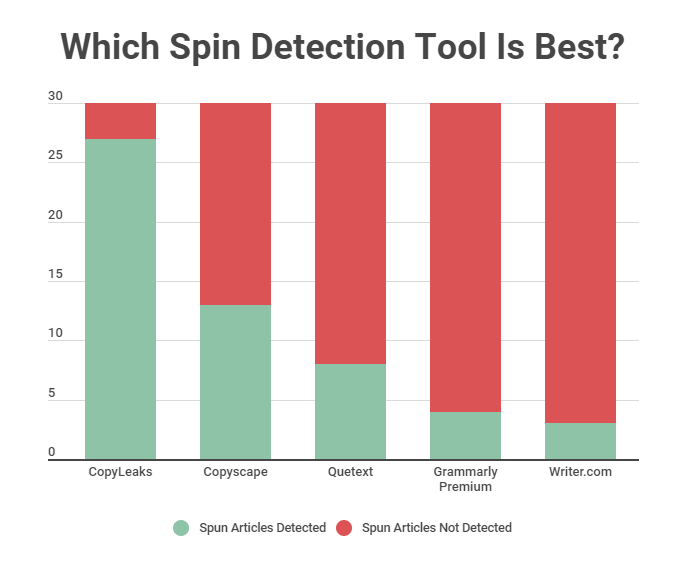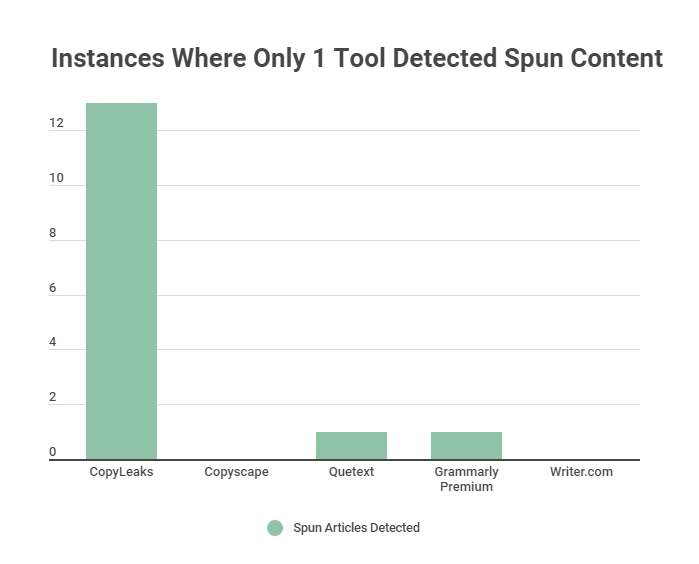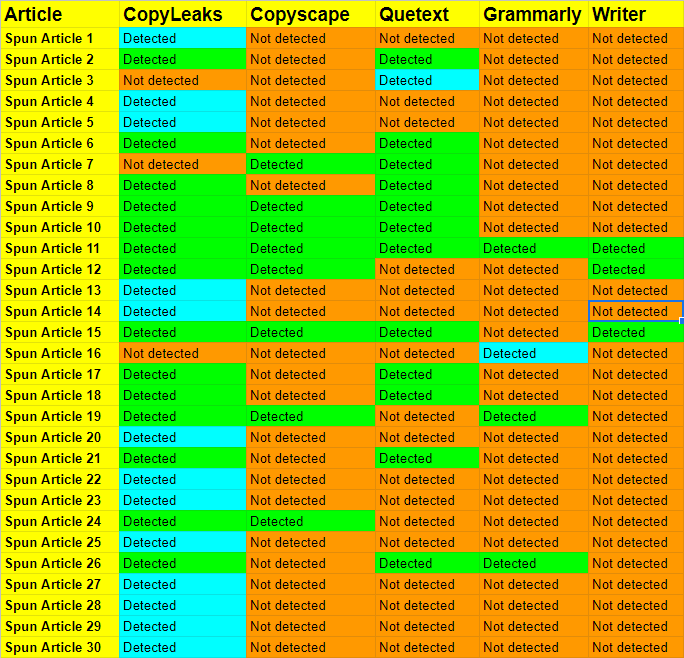The Ultimate Guide to Eradicating Spun Content
The Ultimate Guide to Eradicating Spun Content
Spinning is a huge problem in the content creation industry.

But the truth is that sometimes writers can’t help but spin their content.
And nobody likes to talk about it… especially content agencies.
If you — or the writing agency you’re outsourcing with — don’t check their work carefully, you could end up with a website full of spun articles waiting to get hit by a Google update.
And you’d have absolutely no idea.
As the owner of a high-volume content service, I feel I'm in the perfect position to provide some guidance and perspective on this taboo topic.
Here's what I’ll be sharing with you today:
- • What truly constitutes "spun content."
- • The damage spun content can do to your website (with a real-life example).
- • The ins and outs of our anti-spin process (so you can replicate it and make sure you’re not unwittingly buying spun content from other sources).
- • The best spin checking tool available (based on our internal data).
What Is Spun Content?
Before we start this discussion, it's best that I quickly go over the telltale signs of spun content:
- • Similar sentence structure with word choice slightly altered.
- • Similar flow of ideas from sentence to sentence.
- • Similar subheading structure throughout the entire article.
- • Similar information presented in the same order and/or format.
While some minor similarities between articles about similar topics are to be expected — after all, the point of research is to use information from other sources — you shouldn’t see blatantly obvious similarities between multiple sentences, paragraphs, or subheadings.
The writer should be taking any information they use and synthesizing it into a fresh article with a unique, value-adding take on the topic. They should not be copying another person’s sentences and merely rearranging the structure and vocabulary.
The Dangers of Spun Content
Spun content can hurt your site in a few different ways.
Sitewide Google Penalty
If your site has a surplus of spun content on it, you’re at risk of getting whacked by a Google update.
Don’t believe me? Here’s what Google has to say about it in their Spam Policies documentation:
“Some site owners base their sites around content taken ("scraped") from other, often more reputable sites. Scraped content, even from high quality sources, without additional useful services or content provided by your site may not provide added value to users.”
And one example they give of “scraped content” is...
“Sites that copy content from other sites, modify it only slightly (for example, by substituting synonyms or using automated techniques), and republish it.”
So there you have it. Google is telling you that spun content is a problem and can result in a hit to your traffic.
Now, no one knows to what extent an article has to be spun — or what percentage of your published articles need to contain spun content — for Google to annihilate your site and destroy years of painstaking effort.
However, a sitewide Google penalty isn’t the only way spun content can hurt you.
Individual Article Ranking Issues
Google's algorithm may also take an article’s similarity to other published articles into account when deciding where to rank it.
Individual articles with spun sections may not rank well even if your site as a whole has not been penalized. This is because spun content doesn't add any new value or unique perspective, and Google has no reason to rank your article over the other articles that are already providing the same exact information.
If a substantial number of articles contain elements of spinning, you might find your traffic is significantly stunted.
It Damages Your Authority
Spun content can also hurt you from an authority standpoint.
If you’re trying to position yourself as a leading expert in your niche, it’s not a great look if your audience (or other leaders in the niche) discovers you're copying content from other industry experts.
Other authorities in your niche might turn down valuable collaboration opportunities, which can dampen your potential reach and cause you to lose out on valuable backlinks.
You can also lose the trust of your audience, which may have serious consequences for monetization. If you're going to recommend or sell products to your audience, it's imperative that they trust your opinion. If they don't trust you, they're not going to buy your products, and if they're not going to buy your products, you're not going to make money.
How To Detect Spun Content
In my experience, the only way you can effectively detect spinning is to use a multi-step process that includes using a top-notch spin detection tool and manual analysis from a trained editor.
You need both components to feel truly confident in your spin detection capabilities. Leaving out either one leaves you vulnerable to missing something.
Let me explain how you can combine these strategies to create a formidable anti-spin system.
Step 1: Use Spin Checking Software
Your biggest allies in the fight against spinning are spin-detecting software tools.
There are so many potential sources a writer could choose to spin from. Going one by one and manually comparing your article to the countless related articles out there is a time-consuming and ultimately fruitless task.
To find potential issues quickly, you need the help of software tools that can scan billions of web pages in a few seconds.
In my 4+ years of experience writing blog content, I've found 5 popular tools that claim to detect plagiarism and spun content:
To determine which tool is the best for detecting spun content, I ran an experiment. Let's look at the results below.
Experiment Results
In taking on this experiment, I wanted to quantify two things to help us with our approach to spinning:
- • How much spun content we were detecting and rewriting.
- • How effective each tool is at detecting spun content.
Determining Prevalence of Spun Content
Fortunately, the first task was easy.
We keep track of every single piece of spun content we detect. Our data shows that about 4% of all articles that come through our editing queue are at least partially spun.
I also randomly selected 100 unedited articles, ran them through all 5 tools, and manually analyzed any relevant triggers that appeared.
My findings matched our internal data pretty exactly. Out of 100 random unedited articles, I found 4 with clear signs of spinning.
Tool Efficacy Test
To evaluate tool efficacy, I found 30 articles from the last year that we’ve confirmed to be spun and analyzed how effective each tool was at detecting the spun content.
Here are the results:
- • CopyLeaks: Detected 27/30 spun articles.
- • Quetext: Detected 13/30 spun articles.
- • Copyscape: Detected 8/30 spun articles.
- • Grammarly Premium: Detected 4/30 spun articles.
- • Writer.com: Detected 3/30 spun articles.

And here’s something pretty interesting: 50% of these were only detected by one tool (CopyLeaks):
- • 13/30 were only detected by CopyLeaks.
- • 1/30 was only detected by Quetext.
- • 1/30 was only detected by Grammarly Premium.

For extra context, here’s a screenshot of the spreadsheet I was working in.
- • Green = Tool detected the spun content.
- • Orange = Tool did not detect the spun content.
- • Cyan = Tool was the only tool to detect the spun content.

The results of this experiment are the reason we've decided to use CopyLeaks as our plagiarism and spin detection software tool.
The other tools clearly show some inaccuracy, and any triggers they did pick up were almost always picked up by CopyLeaks as well.
However, even running your articles through the best spin detection tool out there isn’t enough.
You also need to manually analyze the results and determine if the triggers meet the following criteria:
- • They are relevant to your article.
- • They are actually indicative of spinning.
Dealing with False Positives
Before moving on to the manual analysis, I want to discuss one of the most frustrating things I’ve found with some of these tools: they love to give you false positives.
Two tools in particular — Grammarly Premium and Quetext — are notorious for showing triggers that have absolutely nothing to do with your article.
And when they do provide a relevant trigger, that trigger is often coincidental, and it’s clear the writer didn’t actually reference the article that threw the trigger when they were writing.
Note: When I say “relevant trigger”, I’m referring to a trigger from an article that is about a similar topic.
For example, if I were running an article titled “Why Do Goats Faint?” through Grammarly Premium, I might get the following triggers:
- 1. Trigger from an article about car repair.
- 2. Trigger from an article about goat health.
- 3. Trigger from an article about cats.
In this instance, triggers #1 and #3 are irrelevant because the source articles are about completely different topics. Any similarities are purely coincidental and an example of the plagiarism tool being over-sensitive.
However, trigger #2 is relevant because it’s about the same overarching topic (goats). This would require a manual comparison between the two articles to determine if the trigger is coincidental, or if there are clear signs of spinning.
Analyzing relevant triggers to determine whether they’re spun or not is important. You don’t want to waste a perfectly good article just because a tool says there’s a problem.
In fact, in editing tens of thousands of articles, our team has found that the vast majority of relevant triggers are not evidence of spun content.
They’re simply evidence of the tools being oversensitive and recognizing that articles about similar topics are inevitably going to contain some of the same words.
However, within that high percentage of false positives, you may find a few instances of clearcut spinning, which is why it's important to investigate every relevant trigger you find.
Now that we’ve talked about using tools to identify potential problems, let's discuss how you can analyze each trigger and determine if the content is spun.
Step 2: Analyze Relevant Triggers
If the tools find any relevant triggers, the next step is to compare your article with the article that threw the trigger.
To make the comparison easy, you should mark up your Google Doc with comments that highlight the trigger documents and link to the source.
If you’re using a tool that shows you the specific sentences in the trigger article that caused the trigger to appear — CopyLeaks does this — then you can make it even easier by adding a link directly to the sentence in question.
Here’s how you can do it:
- 1. Go to the web page that caused the trigger.
- 2. Find the sentence(s) that caused the trigger.
- 3. Highlight the sentence(s) with your mouse.
- 4. Right-click the highlighted text and select “Copy link to highlight.”
- 5. Go back to your Google Doc and highlight the text you want to compare.
- 6. Add a comment and paste the link in there.
Now you can easily navigate back and forth between the two articles and quickly analyze them. (Or have a member of your team do it.)
If there are any signs of spinning, they should be easy to detect.
Final Thoughts
Spinning is a common problem when outsourcing, and allowing spun content to reach your website can cause big problems if Google decides to take action.
If you’re only going to use a tool for spin detection, make it CopyLeaks. It’s not perfect, but it’s far better than the other tools out there.
And if you want to breathe easy and avoid worrying about any of this altogether, consider getting your SEO blog content from a service that actually takes spinning seriously.
(Based on our experiment data, any service that is running your content through Copyscape or Grammarly isn't getting the most in-depth spin detection possible.)
Here's the bottom line: Google is upping their game, which means website owners — and content services — need to follow suit. If you don't take steps to ensure you're publishing original content, you may pay a big price for it down the road.
Outsourcing with We Write Blog Posts saves you time and money you’d otherwise be spending checking your outsourced content for spinning.
It also gives you the peace of mind that Google won't smite your site whenever they update their spam detection algorithm.
Our spin defense system is far from the only thing we do to add value to your content, but it is an important protection that — to my knowledge — no other service is currently offering.
If you have any questions about how we can help you scale your website's growth at an affordable price, get in touch with us today.

